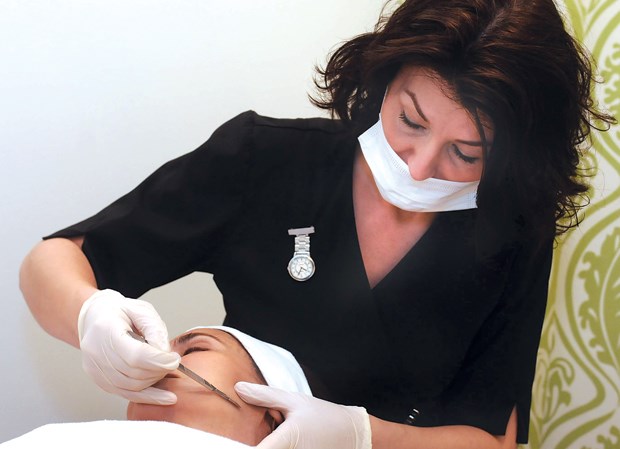There's a new way to exfoliate skin.
Dermaplaning involves using a sterile blade to scrape off the top layer of dead skin cells, ridding the face of vellus hair, or "peach fuzz," at the same time.
"It really gives your skin a lovely sheen, and it's a wonderful anti-aging treatment," says Heather White, an esthetician at Stamford Spa & Salon in Dundarave.
White says dermaplaning is prevalent in the U.S. and Europe, but the treatment is still relatively new in Canada.
"We hold the skin really taut, we wear gloves, and we do it in a really quick motion with the blade," she explains. "You can see the dead skin that comes up on the blade.
"All the black that comes off the skin is really quite amazing," says White. "Even with a good cleansing routine, there's still quite a bit of pollution attached to the skin."
The procedure can remove light surface wrinkling and unblock blackheads, says White.
For those who want to get rid of their peach fuzz, it's also a good option instead of threading, she adds.
The treatment is a good alternative to chemical peels or microdermabrasion because it doesn't use suction or abrasive crystals, she says. "Plus this deep manual exfoliation is fast and quick."
After a microdermabrasion treatment, clients usually feel a sandpaper effect on their face, White says. "But when you're using a blade, you get that smooth effect on the skin."
People who have acneprone skin should not have the dermaplaning treatment, she warns. The blading will over-stimulate their glands and worsen their condition.
White uses about two disposable scalpel blades per client. The procedure takes approximately half an hour and costs $65.
Because the treatment removes two to three weeks worth of dead skin at a time, it's best to get it done roughly once a month, White recommends.
After a treatment, clients get a better product absorption on their skin, she says.
"It really gives you that fresh glow," she says, adding that the procedure has been popular with Madonna and other celebrities.
Compared to chemical peels and some other exfoliation treatments, most clients don't look pink after it's finished, she says.
"There's no needed down time after the treatment," she says. "You might be a little bit sensitive, but you look fine."
Dermaplaning is most popular with women in their 30s to 60s, she says, noting that the procedure can't be done on men because of their facial hair.
Patients need to sign a form explaining that they understand the procedure, including that they can't make any sudden movements or talk, White says.
Women who want to have the procedure done should discontinue use of alpha hydroxy acids, retinol or enzyme products a month before their appointment, White says. They also shouldn't have any laser treatments before dermaplaning. "Anything that munches away at the skin on a daily basis will over-exfoliate skin," she says.
Three days after the procedure, women should do a light exfoliation, she says. Because skin cell production has been stimulated, dead skin is pushed to the surface and some people get a bit dry.
White generally recommends Luzern's hydrating scrub or Elemis's exfoliating products, although this choice can depend on each individual's skin type, she says.
Women should also wear sunscreen after the treatment, she says.
According to Dr. David Zloty, clinical associate professor at UBC's department of dermatology and skin science, dermaplaning is a safe procedure when performed by a professional esthetician who has been properly trained in the treatment, but it should be completed in a medical spa under the supervision of a physician.
"If they're not using proper angulation, pressure and speed, there is a potential to nick and cut the patient," he says.
Zloty's main concern with dermaplaning is that the benefits of the procedure are overstated. While it removes the top layer of skin cells and vellus hair, it's a very superficial removal, he says.
"It makes the skin feel smoother and puts a lustre and glow on the skin, but all that is quite temporary," he says. "There is no evidence to support it as an anti-aging or skin rejuvenation treatment."
Although the treatment might incidentally extract blackheads, it does not treat them, he says.
"Patients won't find an improvement in their skin lines, skin texture, pore size or wrinkling," he says.



